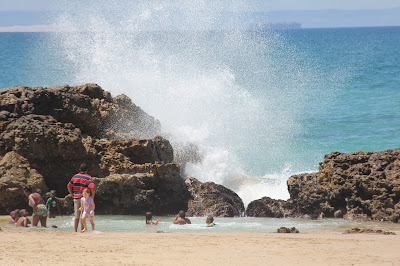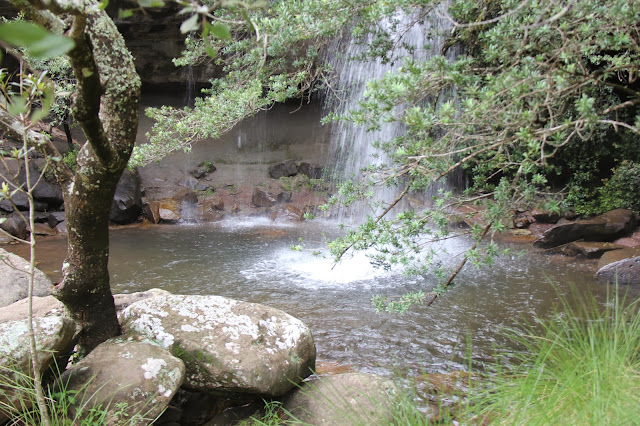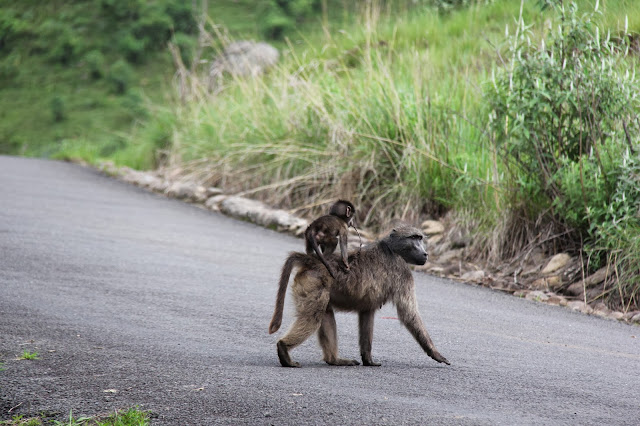Sorry, folks, I can see my blog titles are getting more and more naff! But ... what a way to spend a Christmas Day! We went to the Addo Elephant National Park, about an hour's drive from Port Elizabeth, where we stayed from 23 to 26 December, and where we spent around 6 hours on another self-drive game-spotting trip. There, we saw see dozens and dozens of elephants - both the occasional lone male, as well as several different herds of mothers with their youngsters and babies. At one stage, we'd stopped in our car at a small waterhole for about 45 minutes watching such a herd, only about a hundred yards from us, amongst which was one single bull elephant. After a while, we noticed in the distance a lone bull elephant walking determinedly towards them, and, watching the changed behaviour of the herd, we were fairly confident that this newcomer was not at all welcome. The herd became suddenly still and stiff, and seemed to be bracing themselves for this intrusion. As the bull entered the waterhole, most of the herd stiffly made way for him, for maybe a full 5 minutes. Then, all of a sudden, there was an eyeball-to-eyeball stand-off between the existing bull and the newcomer and, almost before we could think of what to do, the two bulls reared up at each other, roaring loudly, and started the most terrifying fight, with the herd bull chasing off the newcomer - but heading straight to across the road towards our car! At this point, after me screaming at Andy to put his camera down, we reversed quickly down the road to allow the two bulls to chase right past us into the bush the other side of the road. Good grief - can elephants run quickly when aroused! Then, just as we we were breathing a sigh of relief that they'd not trampled over us, the whole herd of mothers and babies took fright and started to run in several directions at once. It was impossible for us to know which way to move the car! Fortunately, however, they all stopped just short of us, or moved around us, and we were able to move slowly up the dirt road, away from where the 'action' was still obviously taking place. Phew!
Only about an hour later - after spotting the largest tortoise we'd ever seen (about two-and-a-half feet long and maybe a foot wide and high)
- we had another reminder about the power and potential aggression of elephants - however friendly, cuddly and placid they may seem at times. We'd stopped at the Rooidam waterhole in the park, where around 50 females and babies had gathered to enjoy some larking about in the water as late afternoon approached. We were absolutely mesmerised! Soon, however, we were joined by a number of other visitors in cars and trucks, and, once again, the behaviour of the elephants changed immediately. Though there were no bulls present, slowly and ploddingly all of the adult females came out of the water and stood in a kind of 'stockade' formation, facing all the cars, and keeping the very young elephants in between their legs, whilst allowing the 'teenagers' to continue to romp around in the dam waters. These females stood just like this for at least 20 minutes - occasionally looking as though they might break out into something a little more aggressive - when we decided it was time to leave them alone to enjoy themselves. But, as I've said, what a way to spend a Christmas Day!
We'd journeyed to Port Elizabeth (or PE, as it's commonly called), after a few days in a wonderfully laid-back and beautiful backpackers lodge in Southbroom - a very pretty, if rather middle-class and 'manicured' town, but with a lovely, unspoilt, rugged rocks and sandy beach, with a lovely Trattoria serving delicious food right on the beach. Our accommodation in Southbroom was in a lovely house with a swimming pool, owned by our very laid-back host, Neville. Every evening, Neville would be visited by about a dozen vervet monkeys (the male of the species having very proudly-displayed bright-blue testicles!), who sat on the wrought-iron bars a few inches outside the kitchen window, rested their feet on the glass, and proceeded to watch those of us inside the house very closely for maybe the next hour or so, following all our movements as we prepared our evening meal, or occasionally turning their attention to the cricket on the TV! Think we really now know what it is like to be in a zoo!
The journey from Southbroom to PE was, however, something of an ordeal. We'd made a conscious decision, for a number of reasons, to travel right across theTranskei region from Southbroom to PE in one go, which we knew would be something of a marathon 8 hours of driving. What we hadn't anticipated, however, was the dreadful weather, the number of potholes on what we had anticipated (wrongly) to be a motorway standard road, and the numerous townships we'd go through en route. As a result, the journey took us a full 12 hours! For most of the way, we were shrowded in thick mists/fog and rain - often only being able to see maybe 50 metres in front of us, and so nothing at all of the Transkei landscape we'd hoped to enjoy. Added to that, it seemed that every time we came to a town had to go right through the middle of it (despite being on the N2 motorway) , rather than by-pass it, and where most were holding their weekly market day, on the day before Christmas Eve! It sometimes took us an hour (at Mthatha nearly two hours!) to get through the people, cattle, over-crowded mini-buses, over-loaded, under-powered, rust-buckets of pick-up trucks and lorries carrying people, chickens, goats, vegetables, etc. criss-crossing each other in every direction, including diagonally, only inches away from each other, and with absolutely no concept of 'lane discipline'! This happened particularly, but not only, at Bizane (where Nelson Mandela married Winnie Mxxxx), at Mathatha (the airport town nearest to Mandela's burial place in Qunu) and another town shrouded in the thickest fog, called Butterworth. By the time we reached PE, we were pretty exhausted!PE itself is a large but fairly pleasant city (though, once again, with a huge, litter-strewn, dilapidated shanty township on its outskirts at Motherwell, which the road towards Addo Elephant Park traverses). In the city itself, there are several long and beautiful beaches, which we'd strolled along on Christmas Eve, and a number of newly-built hotel resorts and shopping malls. Very near to our accommodation, there was a game butcher's shop, and so we were able to buy some ostrich and wildebeest steaks which we cooked on the braai on our return from Addo on Christmas evening.
Next stop: Knysna, which we're told is one of the 'jewels' of the Garden Route. More anon.



























































